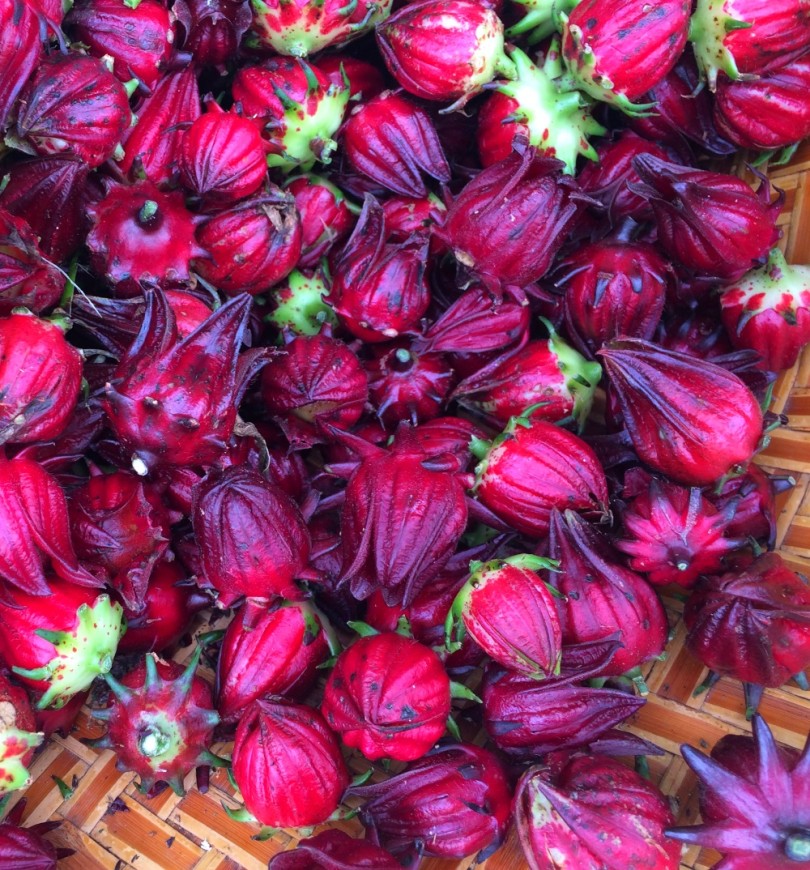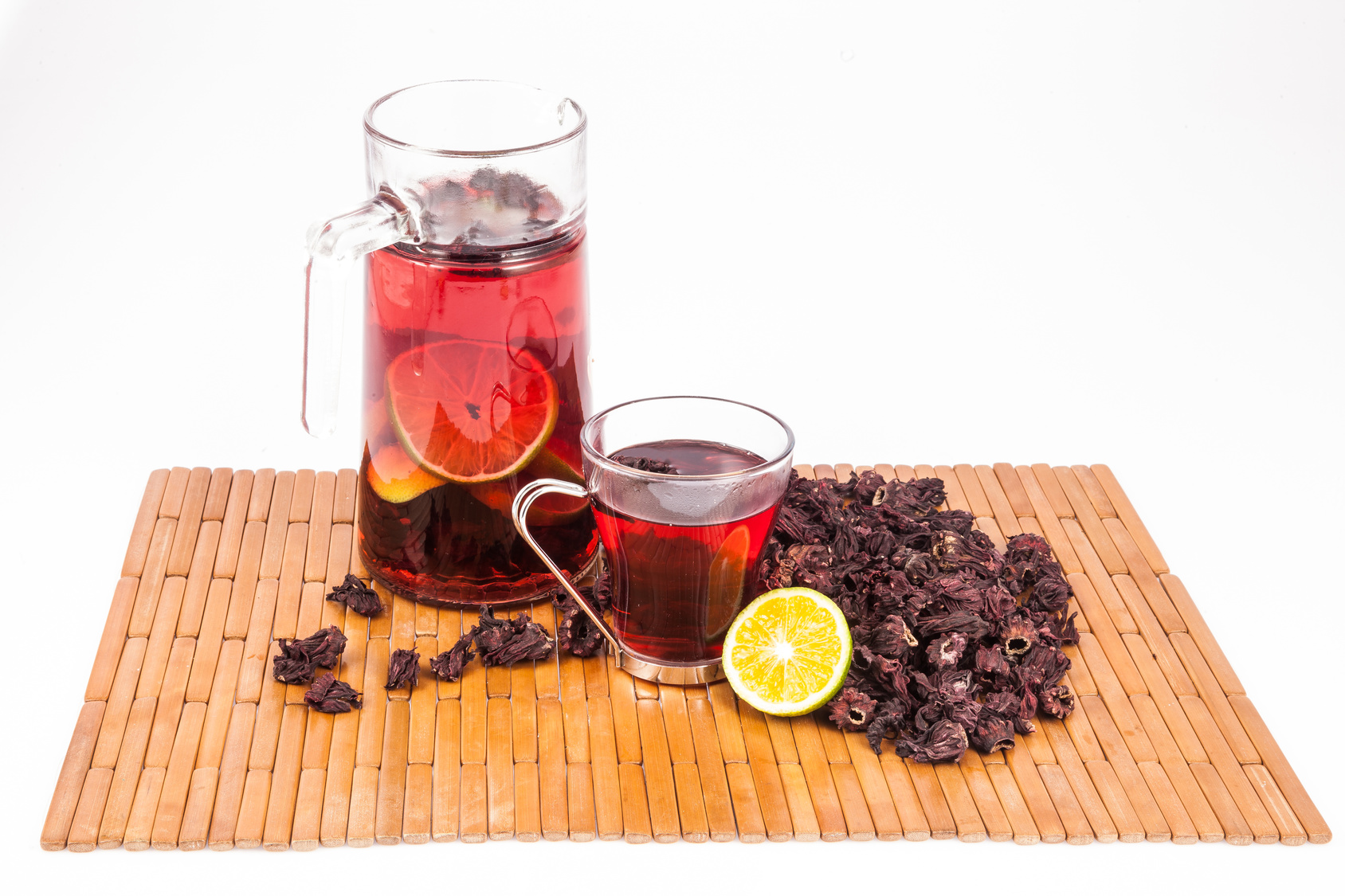Roselle (Hibiscus sabdariffa) or sorrel as it is commonly called in Guyana is a species of hibiscus plant that has many health, traditional and medicinal benefits.
Also called rosella, Jamaican sorrel, or java jute, is a member of the family Malvaceae. The part of the plant that is edible are the calyces of the sorrel flower which can be used to make a variety of jams, sauces, and teas. The tea is deep red in color with sweet and tart flavours that is similar to cranberry, and may be consumed hot or iced.
Where Did Sorrel Come From?
Sorrel is probably native to Africa and now widely naturalized in tropical and subtropical regions of the world particularly in India and Southeast Asia. It is widely grown in Africa, Asia, Papua New Guinea and the Pacific. In the Caribbean regions such as Jamaica, Guyana and Trinidad and Tobago.
Characteristics Of The Sorrel Plant
Sorrel is a broad-leaved, erect and branched annual herb, 2–2.5 m (7–8 ft.) tall. It has a deep penetrating tap root with bulbous, smooth or nearly smooth, cylindrical, typically red stems with spiny hairs.
Leaves are usually alternate, 3 to 5 in (7.5-12.5 cm) long, green with reddish veins and long or short petioles. Leaves of young seedlings and upper leaves of older plants are simple; lower leaves are deeply 3- to 5- or even 7-lobed; the margins are toothed.
Flowers are axillary, solitary, predominantly yellow and red, regular, pediculate; epicalyx of about 12 reddish bracts, connate at base, 10–12 mm long; calyx 15–30 mm long (enlarging in fruit to 40 mm), 5 reddish, large, crescent, fleshy sepals, all sepals fused at base.
Fruit of sorrel is normally dehiscent, 5-valved, non-fleshy, bright red ovoid capsule, 18–20 mm long by 15–18 mm wide. The fruit is green when young and turns into bright red as they mature and consists of 5 valves with each valve containing 3-4 seeds. Later, capsule turns brown and split open when completely mature and dry. Seeds are normally kidney shaped, light brown, 3-5 mm long and covered with minute stout and stellate hairs.
Nutritional Value Of Sorrel
Sorrel is a good source of nutrients, vitamins and minerals. Consuming 57 gram of sorrel offers 123 mg of Calcium, 0.84 mg of Iron, 6.8 mg of Vitamin C, 29 mg of Magnesium, 6.45 g of Carbohydrate, 21 mg of Phosphorus, 119 mg of Potassium, 0.016 mg of Vitamin B2 and 8 µg of Vitamin A.

Sorrel
Here Are 5 Amazing Health Benefits Of Sorrel
- Maintains Healthy Teeth and Gums – Calcium present in sorrel protects teeth by keeping the jaw bone strong and sturdy throughout your life, which in turn ensures tight fitting teeth where bacteria cannot thrive. Therefore, before your teeth and gums start giving you any trouble, be sure to maintain a calcium rich diet. Its intake should be high, especially at young ages, so that your children naturally grow up with strong teeth.
- Healthy Pregnancy – Pregnant women should consume more iron rich foods than anyone else. So including iron rich food like sorrel is quite beneficial for pregnant women as they require around 27 mg daily and this is often covered in a pre-natal multi-vitamin. Also, pregnant women should consider consuming more healthy fat and folate rich foods during pregnancy.
- Treatment of the Common Cold – Sorrel consists of Vitamin C which helps to enhance the immune system of our body, which protects us from colds and coughs. Apart from that it facilitates the absorption of iron and thus strengthens the body’s resistance to infection. It also fights against viruses.
- Prevents constipation – Magnesium present in sorrel provides quick relief from constipation, and a high dose of water-soluble magnesium supplements is known to bring sound relief for even the most severe constipated state. The laxative property of this vitamin help to relaxes the intestinal muscles, thus helping to establish a smoother rhythm while passing bowels. It also has another property of attracting water, which in turn softens the stool and helps it to pass easily. Sorrel consists of 29 mg of magnesium which is actually 6.90% of the daily recommended value.
- Weakness – Sorrel consists of Phosphorous that has the ability to remove minor health problems like muscle weakness, numbness, fatigue and other similar ailments. Normal levels of phosphorous in the body are a great way to remain fit and active. A normal amount can be around 1200 mg for adults, according to experts and from suggestions of various health practitioners. Sexual weakness can also be cured with healthy supplementation of phosphorous into the body, so issues like loss of libido, frigidity, impotence, and sperm motility can be boosted by having an adequate supply of phosphorus in your system.
Culinary Uses Of Sorrel
- Fleshy flower calyces are rich in citric acid, pectin, anthocyanin pigments and vitamins and are used fresh in salad and for making sorrel wine, syrup, gelatin, refreshing beverages, puddings, chutneys, pickles, cakes, herbal teas, jellies, marmalades, ices, ice cream, sherbets, butter, pies, sauces, tarts and other desserts.
- Sorrel has been recommended as a source of pectin for the fruit-preserving industry in Pakistan.
- Calyces are used for food coloring in America, Asia and Europe.
- Calyces are used to color and flavor rum in the Caribbean and to add color and flavor to herbal teas and beverages.
- Sorrel calyces are commonly used to make a sugary herbal tea that is commonly sold on the street in Africa especially Sahel.
- Calyces are used to make cold, sweet drinks popular in social events, often mixed with mint leaves, dissolved menthol candy, and or various fruit flavors in Mali and Senegal.
- Carib Brewery Trinidad Limited produces a Shandy Sorrel in which sorrel tea is combined with beer in Trinidad and Tobago.
- Young leaves and shoots cooked as vegetables and the calyces used to flavor fish and in curries in Malaysia.
- Young leaves, stems, calyx and fruits are used for cooking fish or eel in Vietnam.
- Tender young leaves and stems eaten raw or cooked in Nepal and elsewhere.
- Leaves used as food complement in Angola.
- Seeds have been reported to be eaten in some parts of Africa.
Traditional And Medicinal Uses Of Sorrel
- Sorrel flowers, leaves and to a lesser extent seeds and roots have been used in traditional medicine in the tropics as antiseptic, aphrodisiac, astringent, cholagogue, demulcent, digestive, diuretic, emollient, purgative, dysuria, fever, hangover, heart ailments, hypertension, neurosis, scurvy, antipyretic, refrigerant, resolvent, sedative, mild laxative, stomachic and tonic and as a folk remedy for abscesses, bilious conditions, cancer, cough, debility, dyspepsia and strangury.
- Sorrel drink made by placing, the calyx in water, is supposed to be a folk remedy for cancer.
- Medicinally, leaves are emollient and are much used in Guinea as a diuretic, refrigerant and sedative; fruits are antiscorbutic; leaves, seeds and ripe calyces are diuretic and antiscorbutic; and the succulent calyx, boiled in water, is used as a drink in bilious attacks; flowers contain gossypetin, anthocyanin and glucoside hibiscin, that may have diuretic and choleric effects, reducing the viscosity of the blood, reducing blood pressure and stimulating intestinal peristalsis.
- Seeds are used for debility and the leaves as emollient in Burma.
- Taiwanese regard the seed as diuretic, laxative and tonic.
- Angolans use the mucilaginous leaves as an emollient and as a soothing cough remedy.
- Sorrel is an aromatic, astringent, cooling herb that is much used in the Tropics.
- Leaves are antiscorbutic, emollient, diuretic, refrigerant and sedative.
- Bitter root is used as an aperitif and tonic in Philippines.
- Sorrel is used as antidotes to poisonous chemicals (acids, alkali, and pesticides) and venomous mushrooms in traditional medicine.
- Leaves are occasionally used as medicine in dysentery of man and domestic animals in Assam.
- Powdered calyces are used as an aphrodisiac on the penis, leaf juice is used as eye drop and oxytocic and pulp of the roots is used as local application for abscess and administered for bronchitis in Brazzaville.
- Finely powdered dried fruit is applied to sores and wounds in Togo.
- An infusion of the calyx is used to treat haematuria and headache and decoction used for snake bite and scorpion sting in Sudan.
- Powdered sorrel fruit mixed with powdered tamarind bark is used as local application for old wounds; powdered macerated sorrel flowers are similarly used in Dogonland, Mali.
- Tea from crushed leaves soaked in water is taken orally for epilepsy in Temeke district, Tanzania.
- Decoction of fresh leaves is taken orally for anaemia in Uganda.
- Leaves are used for tuberculosis in Ogun State, Nigeria.
- Juice from pounded leaves is used as coagulant with latex in Madagascar.
- Sorrel flowers are used in traditional treatment of malaria in Cameroon.
- Leaf decoction is used as mouth gargle in Central African Republic.
- Crushed seeds are used as veterinary medicine in Burkina Faso.
5 Interesting Facts About Sorrel
- Sorrel is an annual multi-use crop used in food, animal feed, nutraceuticals, cosmeceuticals and pharmaceuticals.
- The strong base fiber obtained from the stem is used for various household purposes including making sackcloth, gunnies, twine, ropes, cord and cordage and as a substitute for jute in the manufacture of burlap.
- Yellow dye is obtained from the petals and used in medicine, etc. . . .
- Seeds are fed to cattle in some parts of Africa and poultry.
- Seed yields 20 % oil which is useful as a lubricant.
Here is how to make sorrel drink (Guyanese style)
Ingredients:
- 2 cups of sorrel calyces, washed and with seeds removed
- 2 litres of water
- Juice from one-half of a lemon or lime (optional)
- 3/4 cup of sugar or to taste
Method:
- Combine the calyces and water in a large pot and bring to a full boil. Remove from stove and let steep covered for 30 minutes. The color should be a deep red-purple, like some kinds of grape juice. At this stage, some people recommend refrigerating the mixture for 24 hours. Others proceed immediately.
- Strain off the liquid through a sieve and throw away the sorrel calyces.
- Stir in lemon juice and sugar.
- Serve hot or cold.
Watch This: Caribbean Pot: How To Make Sorrel Drink
About Sorrel
Cultivated worldwide today, this amazing plant is packed with many medicinal, health and traditional benefits. In Guyana, the calyces of the sorrel flower is use to make drink and is consumed throughout the year, preferably cold. The sorrel plant can be found in many Guyanese home gardens.
Article References:
- https://www.britannica.com/plant/roselle-plant
- http://gardeningsolutions.ifas.ufl.edu/plants/edibles/vegetables/roselle.html
- https://bodynutrition.org/roselle/
- https://www.organicfacts.net/health-benefits/beverage/hibiscus-tea.html
- https://www.esgreen.com/info/the-health-benefits-of-roselle-or-hibiscus/
- https://www.medicalnewstoday.com/articles/318120.php
- https://www.healthbenefitstimes.com/roselle/







